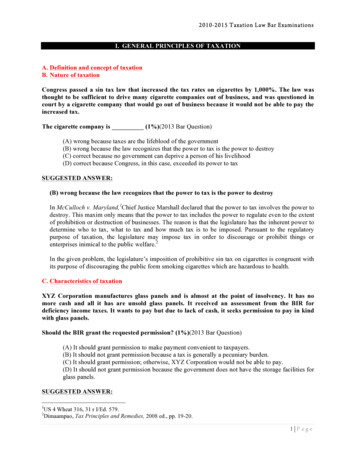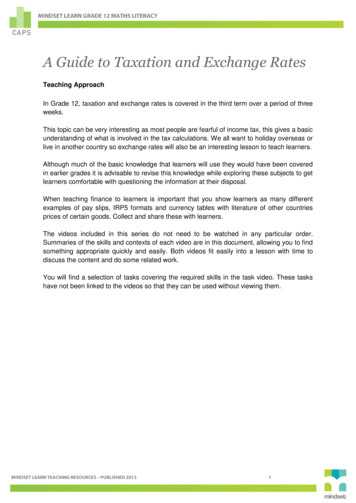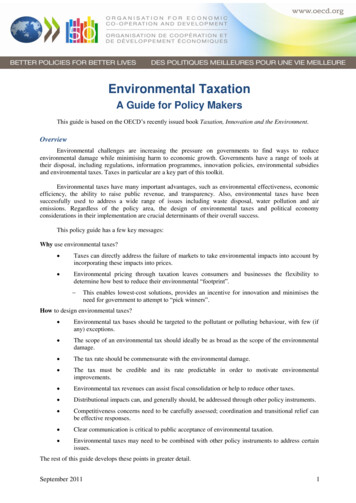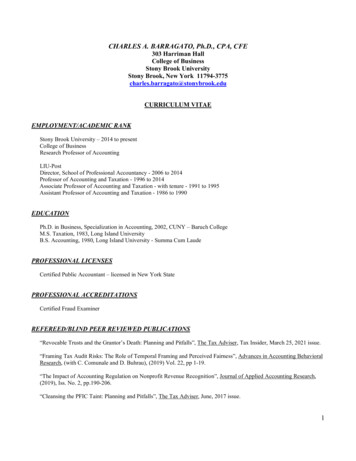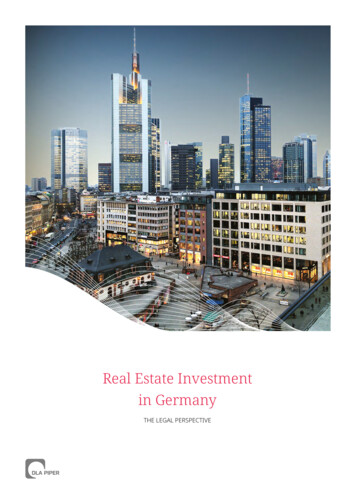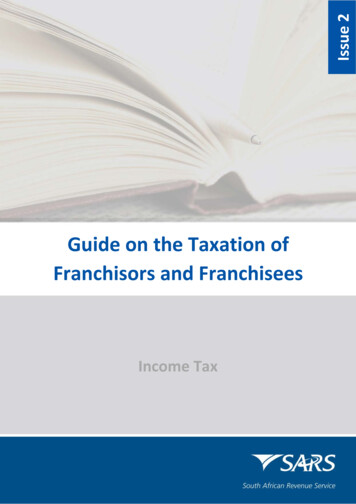
Transcription
Issue 2Guide on the Taxation ofFranchisors and FranchiseesIncome Tax
Guide on the Taxation of Franchisors and FranchiseesPrefaceThis guide considers the income tax implications of specified income received and specifiedexpenditure incurred by franchisors and franchisees.It is not an “official publication” as defined in section 1 of the Tax Administration Act 28 of 2011and accordingly does not create a practice generally prevailing under section 5 of that Act. Itis also not a binding general ruling under section 89 of Chapter 7 of the Tax AdministrationAct. Should an advance tax ruling be required, visit the SARS website for details of theapplication procedure.This guide is based on the legislation as at date of issue.All guides, interpretation notes, forms, returns and tables referred to are available on the SARSwebsite at www.sars.gov.za. Unless indicated otherwise, the latest issues of thesedocuments should be consulted.For more information you may – visit the SARS website at www.sars.gov.za; visit your nearest SARS branch after making an appointment via the SARS website; have a virtual consultation with a SARS consultant by making an appointment via theSARS website; contact your own tax advisor or tax practitioner; or contact the SARS National Call Centre – if calling locally, on 0800 00 7277; or if calling from abroad, on 27 11 602 2093 (only between 8am and 4.30pmSouth African time).Comments on this guide may be emailed to policycomments@sars.gov.za.Leveraged Legal ProductsSOUTH AFRICAN REVENUE SERVICEDate of 1st issue:21 July 2016Date of 2nd issue :16 August 2021Guide on the Taxation of Franchisors and Franchisees (Issue 2)i
ContentsPreface . iGlossary . 11.Introduction . 12.The franchise arrangement. 13.Taxation of franchisors and franchisees . 1.23.123.13General principles . 2Creation or acquisition of intellectual property . 5Tax implications for franchisors: deduction for costs incurred in creating or acquiringintellectual property . 5Tax implications for franchisors and franchisees: drawing up legal agreements for utilisationof the intellectual property created or acquired . 7Upfront fees . 7Tax implications for franchisors: receipt of an upfront fee . 8Tax implications for franchisees: payment of the upfront fee . 9Licence fee and/or an initial fee . 9Tax implications under section 11(f) . 11Higher royalty payments in lieu of upfront payments . 13Other . 14Royalty payments . 14Tax implications for franchisors . 15Tax implications for franchisees . 15Royalties on “tainted intellectual property” . 17Withholding tax on royalties . 21Early cancellation of a franchise agreement . 21Compensation paid by a franchisor for early cancellation of a franchise agreement . 21Compensation paid by a franchisee for early cancellation of a franchise agreement . 23Penalties for breach of contract . 24Renewal fees . 25Advertisement fees . 25Tax implications for franchisors . 25Tax implications for franchisees . 25Training fees . 26Tax implications for franchisors . 26Tax implications for franchisees . 26Capital gains tax . 26Restraint of trade payments . 284.Conclusion . 283.2.2Guide on the Taxation of Franchisors and Franchisees (Issue 2)ii
GlossaryIn this guide unless the context indicates otherwise – “CGT” means capital gains tax, being the portion of normal tax attributable to theinclusion in taxable income of a taxable capital gain; “Copyright Act” means the Copyright Act 98 of 1978; “Designs Act” means the Designs Act 195 of 1993; “Income Tax Act” means the Income Tax Act 58 of 1962; “Patents Act” means the Patents Act 57 of 1978; “section” means a section of the Income Tax Act; “Schedule” means a Schedule to the Income Tax Act; “taxpayer” and “person” are used interchangeably; “Trade Marks Act” means the Trade Marks Act 194 of 1993; and any other word or expression bears the meaning ascribed to it in the Income Tax Act.1.IntroductionThe franchise industry in South Africa is a major contributor to the South African economy.There is a need for clarity concerning the tax implications that arise in relation to franchisearrangements, in particular, the income tax treatment of specified income received or accruedand specified expenditure incurred by franchisors and franchisees under franchiseagreements. The aim of this guide is thus to assist in clarifying uncertainties that may arise onthe application of the income tax laws to a franchise arrangement.This guide focuses mainly on transactions between franchisors and franchisees that areresident in South Africa.2.The franchise arrangementIn order to facilitate a better understanding of the franchising industry, some of the mostcommonly used terms relating to franchises, as defined by the International FranchiseAssociation, 1 are listed below:1 Business format franchise: This type of franchise includes not only a product, serviceand trademark, but also the complete method to conduct the business itself, such asthe marketing plan and operations manuals. Franchise: A licence that describes the relationship between the franchisor andfranchisee, including the use of trade marks, fees, support and control. Franchising: A method of business expansion characterised by a trade mark licence,payment of fees and significant assistance and/or control. Franchisor: The person or company that grants the franchisee the right to do businessunder its trade mark or trade -terms-and-definitions [Accessed16 August 2021].Guide on the Taxation of Franchisors and Franchisees (Issue 2)1
Franchisee: The person or company that acquires the right from the franchisor to dobusiness under the franchisor’s trade mark or trade name. Franchise agreement: The legal, written contract between the franchisor andfranchisee which tells each party what each is supposed to do. Product distribution franchisee: A franchise in which the franchisee simply sells thefranchisor’s products without using the franchisor’s method of conducting business. Royalty: The regular payment made by the franchisee to the franchisor, usually basedon a percentage of the franchisee’s gross sales. Trademark: The marks, brand name and logo that identify a franchisor which islicensed to the franchisee.A franchise arrangement will usually enable a franchisee to operate a business under specificlicensing conditions. As noted above, a business format franchise arrangement provides thefranchisee with a strong brand (intellectual property) and “the complete method to conduct thebusiness itself, such as the marketing plan and operations manuals” (business processes). Bycontrast, a product distribution franchise arrangement enables the franchisee to sell thefranchisor’s products but does not involve the franchisor providing the franchisee with itsmethod of conducting business. This guide is focused on the business format franchisearrangement (hereinafter referred to as a “franchise”), however, many of the conceptsexamined in this guide will often also apply to a product distribution franchise arrangementand other variations of franchise arrangements.The franchisor that establishes or develops a concept normally uses franchisees to duplicateand distribute the concept on a large scale. The success of a franchise chain lies in theeffective implementation of basic, but clearly defined, business principles that have beenestablished by the franchisor.23.Taxation of franchisors and franchisees3.1General principlesA franchisor’s income and a franchisee’s expenditure can, respectively, include a wide rangeof amounts received or accrued, and incurred, which are stipulated in the franchise agreement.A franchisor, for example, may receive payments such as initial fees, renewal fees androyalties from a franchisee. In exchange, the franchisor has to provide the necessaryintellectual property and business processes to enable the franchisee to operate the franchise.The franchisee incurs initial expenditure in setting up the franchise outlet, as well asexpenditure relating to the day-to-day running of the franchise, which can either be in the formof once-off or recurring payments.This section of the Guide provides commentary on some of the general principles and sectionswhich underlie the taxability or tax deductibility of many amounts that are received by or accrueto, or are paid or incurred by, franchisors and franchisees. Some of these principles andsections are also applied in the commentary in 3.2 to 3.11 below which explains the taxtreatment of specified types of income and expenses relevant to franchisors, franchisees andfranchise agreements.2www.fasa.co.za/what-is-franchising/ [Accessed 16 August 2021].Guide on the Taxation of Franchisors and Franchisees (Issue 2)2
A receipt of an amount by a franchisor or franchisee may constitute “gross income” as definedin section 1(1). “Gross income”, in the case of a resident, is the total amount received oraccrued during the year of assessment, regardless of the country of source, but excludingreceipts and accruals of a capital nature. This definition also includes a number of specifiedamounts irrespective of whether the amount is capital or revenue in nature.The courts have developed a number of tests for determining the capital or revenue nature ofreceipts and accruals. For example, there is the “tree versus the fruit” test, and the realisationof a capital asset versus the making of a gain in carrying out a scheme of profit-making test.In CIR v Visser, Maritz J stated the following: 3“If we take the economic meaning of ‘capital’ and ‘income’ the one excludes the other. ‘Income’is what ‘capital’ produces, or is something in the nature of interest or fruit as opposed to principalor tree.”In Californian Copper Syndicate (Limited and Reduced) v Harris (Surveyor of Taxes), 4 whichwas quoted with approval in Overseas Trust Corporation Ltd v CIR, 5 Clerk LJ stated thefollowing:“ the question to be determined being – [i]s the sum of gain that has been made a mereenhancement of value by realising a security, or is it a gain made in an operation of businessin carrying out a scheme for profit-making?”See the Comprehensive Guide to Capital Gains Tax for detail on the different tests.All amounts that a resident franchisor or franchisee receives will thus fall into gross income,with the exception of those of a capital nature. For a non-resident, “gross income” is the totalamount received or accrued from a source within South Africa, but excluding receipts andaccruals of a capital nature.Often for expenses or losses to qualify for a deduction from a franchisor’s or franchisee's“income”, 6 the requirements set out in section 11(a) read with section 23(g) must be compliedwith.Under these sections the expense or loss must – be actually incurred; be in the production of the franchisee’s or franchisor’s income; be laid out or expended for the purposes of trade; and not be of a capital nature.Expenses and losses must generally (see section 23H below) be claimed as a deductionunder section 11(a) read with section 23(g) in the year of assessment in which the expenseor loss is actually incurred.34561937 TPD 77, 8 SATC 271 at 276.41 Sc LR 694, 5 TC 159 at 166.1926 AD 444, 2 SATC 71.“Income” is gross income after deducting any amounts exempt from tax.Guide on the Taxation of Franchisors and Franchisees (Issue 2)3
The capital or revenue nature of the expenditure will often determine whether the expenditurequalifies for a deduction under section 11(a) provided that all the other requirements of thesection are met and a more specific section is inapplicable 7 or whether it potentially qualifiesfor a capital allowance over a number of years (considered below with reference to specifictypes of expenses).The courts have developed a number of tests for determining the capital or revenue nature ofexpenditure. 8 The cases below highlight two important principles.In New State Areas Ltd v CIR Watermeyer CJ, after reviewing a number of decisions of thecourts in the United Kingdom, said: 9“The conclusion to be drawn from all of these cases seems to be that the true nature of eachtransaction must be enquired into in order to determine whether the expenditure attached to itis capital or revenue expenditure. Its true nature is a matter of fact and the purpose of theexpenditure is an important factor; if it is incurred for the purpose of acquiring a capital assetfor the business it is capital expenditure even if it is paid in annual instalments; if, on the otherhand it is in truth no more than part of the cost incidental to the performance of the incomeproducing operations, as distinguished from the equipment of the income producing machine,then it is a revenue expenditure even if it is paid in a lump sum.”In CIR v George Forest Timber Company Ltd, Innes CJ held as follows: 10“Money spent in creating or acquiring an income-producing concern must be capitalexpenditure. It was invested to yield future profit and while the outlay did not recur, the incomedid. There was a great difference between money spent in creating or acquiring a source ofprofit, and money spent in working it. The one was capital expenditure, the other was not.”(Emphasis added)If a person has actually incurred expenditure (excluding expenditure incurred to acquiretrading stock) during a year of assessment for which a deduction is allowable undersections 11(a), 11(c), 11(d), 11(w) or 11A, that deduction may be limited under section 23H ifthe expenditure relates to – goods or services, all of which will not be supplied or rendered to the person duringthat year of assessment, or any other benefit, the period to which the expenditure relates extends beyond that yearof assessment.Section 23H essentially provides for the deferral of a deduction of pre-paid expenditure, whichis then spread over the number of years of assessment during which the goods are supplied,the services rendered or the benefits enjoyed.Most amounts which were allowed to be deducted or set off in a current or a previous year ofassessment and which have been recovered or recouped during the current year ofassessment must be included in a taxpayer’s income in the current year of assessment. 117891011Section 23B(3).See the Comprehensive Guide to Capital Gains Tax for detail on the different tests.1946 AD 610, 14 SATC 155 at 170.1924 AD 516, 1 SATC 20 at 26. This approach has subsequently been reaffirmed on numerousoccasions by our courts.See, for example, section 8(4)(a).Guide on the Taxation of Franchisors and Franchisees (Issue 2)4
Section 24C 12 provides for the deduction of an allowance if a taxpayer’s income for theparticular year of assessment includes an amount which has been received by or accrued tothe taxpayer in terms of a contract and all or part of that amount will be used to finance “futureexpenditure” 13 which will be incurred by the taxpayer in performing the taxpayer’s obligationsunder that contract. An allowance claimed under section 24C must be reversed in thesubsequent year of assessment.In C: SARS v Big G Restaurants (Pty) 14 the taxpayer was a franchisee that operatedrestaurants under various franchise agreements with the Spur Group (Pty) Ltd (the franchisor).Under the franchise agreement the franchisee was required to upgrade and refurbish itsrestaurants at reasonable intervals determined by the franchisor and subject to certainapprovals from the franchisor. The taxpayer sought to claim an allowance under section 24Cfor these future upgrade and restoration costs. Applying a narrow meaning of “in terms of”used in section 24C(2), the Court held that the income-earning and obligation-imposingcontract must be the same contract and that the franchisee did not receive any income underthe franchise agreement. The Court stated that even though a contract is useful or necessaryto enable a taxpayer to earn income, it does not mean that the taxpayer’s income is earned“in terms of” such contract. Accordingly, the requirements in section 24C were not met andsection 24C was held not to apply. SARS also contended that there was no future expenditureas it was conditional. However, having found that the income requirement had not been met,it was not necessary for the Court to decide on this aspect. On appeal the ConstitutionalCourt 15 held that two or more contracts may be so inextricably linked that they meet therequirement of “sameness”, 16 however, on the facts of Big G’s case the Constitutional Courtfound the sameness requirement was not met and the section was inapplicable. 173.2Creation or acquisition of intellectual property3.2.1Tax implications for franchisors: deduction for costs incurred in creating oracquiring intellectual propertyIn order to determine whether the cost incurred by a franchisor in developing or acquiringintellectual property qualifies as a deductible expense under section 11(a) (see 3.1), the natureof the expenditure as well as the purpose of the expenditure must be evaluated. In determiningwhether the expenditure is of a capital or revenue nature it is necessary to differentiatebetween expenses incurred to create an income-producing structure and those incurred tooperate the income-producing structure.The costs incurred by a franchisor in –12131415161718 obtaining a patent; devising or developing an invention; 18See Interpretation Note 78 “Allowance for future expenditure on contracts” for detail on section 24C.As defined in section 24C(1).2019 (3) SA 90 (SCA), 81 SATC 185. The taxpayer appealed the SCA judgment in the ConstitutionalCourt (see below).Big G Restaurants (Pty) Ltd v CSARS 2020 (6) SA 1 (CC), 82 SATC 403.“Sameness” referring to the requirement that the income-earning and obligation-imposing contractmust be the same contract.For completeness we note that in Clicks Retailers (Pty) Limited v CSARS CCT07/20, theConstitutional Court gave further consideration to the meaning of two or more contracts being soinextricably linked that they satisfy the requirement of “sameness”.See Interpretation Note 50 “Deduction for Scientific or Technological Research and Development”for more information on inventions in relation to section 11D.Guide on the Taxation of Franchisors and Franchisees (Issue 2)5
creating or producing a design, copyright or any property of a similar nature; registering a trademark, trade name or design; restoring or extending any patent; extending the registration period for a design; and renewing the registration of a trade mark or trade name,would in most instances be capital in nature since it is regarded as money spent in creating oracquiring an income-producing asset and not in operating the income-producing structure.Subject to certain requirements, the expenses referred to above could, however, be deductibleunder other sections in the following circumstances: Section 11(gB) provides for the deduction of expenditure actually incurred during theyear of assessment in obtaining the granting, the restoration or the extension of theterm of any patent, the registration or extension of registration of any design, or theregistration or renewal of registration of a trade mark if the patent, design or trade markis used by the taxpayer in the production of the taxpayer’s income. Section 11(gC) provides for an allowance of 5% or 10% (depending on the type ofasset) a year of the expenditure actually incurred during years of assessmentcommencing on or after 1 January 200419 to acquire (otherwise than by devising,developing or creating) any – invention or patent as defined in the Patents Act; design as defined in the Designs Act; copyright as defined in the Copyright Act; other property of a similar nature (other than trade marks as defined in theTrade Marks Act); or knowledge essential to the use of such invention, patent, design, copyright,other property or the right to have such knowledge imparted. Section 11D provides various deductions for specified scientific or technologicalresearch and development including, for example, creating or developing an inventionor functional design, as defined. 20 Research and development for purposes ofsection 11D specifically excludes the creation or enhancement of trademarks orgoodwill.Additionally, a franchisor whose trade relates to gambling, telecommunications or theexploration, production or distribution of petroleum and who is required to obtain a licence totrade from the national, provincial or local government or certain specified constitutionalinstitutions or public entities may claim a deduction for the licence fees under section 11(gD).The deduction under section 11(gD) must not exceed, for any one year, such portion of thelicence fee as is equal to the amount of the expenditure divided by the number of years forwhich the taxpayer has the right to the licence after the date on which the fee is incurred, or30 years, whichever is the lesser.1920Certain expenditure incurred prior to 1 January 2014 in relation to inventions, patents, designs,trade marks or copyright may have been deductible under section 11(gA).See section 11D for detail.Guide on the Taxation of Franchisors and Franchisees (Issue 2)6
Example 1 – Deductibility of expenditure incurred in the registration of intellectualproperty by a franchisorFacts:Following the success of X’s Fine Dining Restaurant, X embarked on a project in 2020 ofexpanding the business by creating a franchise chain. X’s Fine Dining flourished as acelebrated and respected franchise chain. Before the commencement of the franchisebusiness, X licensed the intellectual property developed by it, which included the registrationof a trade mark as well as the registration of a design.Result:The registration of X’s intellectual property was obtained with the objective of creating anincome-earning structure. As such, the registration expenditure represented money spent increating or acquiring an income-producing concern and was therefore of a capital nature. Theregistration expense was thus not deductible under section 11(a). However, section 11(gB)applied since this section specifically provides for the registration of intellectual property anda deduction of this expense was thus allowable under that section.3.2.2Tax implications for franchisors and franchisees: drawing up legal agreementsfor utilisation of the intellectual property created or acquiredSituations may arise in which a franchisor may bear the costs of drafting a franchiseagreement. In these cases, the costs incurred by a franchisor in drawing up the franchiseagreement are part of the costs of operating the franchisor’s income-earning structure whichincludes its intellectual property and business processes. The fee is consequently regardedas being of a revenue nature and thus deductible under section 11(a).With regard to the costs incurred by the franchisee in drawing up a franchise agreement, thesecosts will be linked to the establishment of the franchisee’s income-earning structure which isa capital asset and will thus be non-deductible under section 11(a).3.3Upfront feesAn upfront fee, comprising of a licence fee and/or an initial fee, is usually paid by a franchiseeto a franchisor to enable the franchisee to use the franchisor’s intellectual property andbusiness processes including operational standards and procedures. This fee is generally paidbefore commencement of trade by the franchisee. The bundle of rights that is acquired by thefranchisee relates not only to the acquisition of the right of use of the franchisor’s intellectualproperty and business processes (licence fee), but also a myriad of other goods and servicesnecessary for the launch and continuing operation of the franchise (initial fee).As noted by the International Franchise Association, under a usual franchise arrangement – 21“the franchisor provides to the franchisee not just its trade name, products and services, but anentire system for operating the business site selection and development support, operatingmanuals, training, brand standards, quality control, a marketing strategy and business advisorysupport ”(Emphasis anchise [Accessed 16 August 2021].Guide on the Taxation of Franchisors and Franchisees (Issue 2)7
Therefore, the upfront fee generally does not relate only to the grant by the franchisor to thefranchisee of the right of use of its intellectual property, but also to other items, such as – sales and production forecasting; initial training of staff and management; forecasting of staff requirements; territory analysis; site identification; operating procedures and standards; branding utilisation; and supply chain management.No uniform upfront fee rate applies since the fee varies between the different types offranchises and in some instances between franchises of the same type. For example, someagreements will provide for separate fees to be paid as a licence fee and an initial fee or ahigher royalty payment could be paid to secure the rights to operate the franchise in lieu of anupfront payment.The income tax consequences of some of these upfront fees are considered below.3.3.1Tax implications for franchisors: receipt of an upfront feeThe upfront fee paid by a franchisee to the franchisor is usually paid in the form of an upfrontlump sum payment. The upfront fee is paid by the franchisee for the acquisition of the right touse the franchisor’s intellectual property and business processes as well as the right to tradein an exclusive use area. 22 The upfront fee is thus regarded as the product or fruit derived bya franchisor from putting its capital assets to productive use 23 and is therefore not regardedas a receipt of a capital nature. An upfront fee received by a franchisor will consequently formpart of the gross income 24 of the franchisor.In ITC 1738 25 an initial fee was paid to the franchisor for the use of the franchisor’s“identifications” such as the trademark, designs, advertising matter and signage as well as theskills, know-how and technical information relating to planning, setting-up and operating thefranchisor’s know-how. SARS argued that the initial fee was gross income as it was receivedas consideration for granting the franchisee a temporary right to use the franchisor’s asset andit was therefore the fruit received from putting its capital asset to productive use. It was alsosubmitted that the fruit was a gain made by an operation of business in carrying out a schemefor profit making. The court agreed and held that the franchisor’s intellectual property andbusiness processes, that continued to be owned by it, had been productively used by thefranchisor to earn income from the granting of th
intellectual property and business processes to enable the franchisee to operate the franchise. The franchisee incurs initial expenditure in setting up the franchise outlet, as well as expenditure relating to the day -to-day running of the franchise , which can either be in the form of once-off or recurring payments.





